Binoculars for Wildlife & Astronomy
The question for the BinoWizard this week comes from Simon, a BBR Patreon supporter who is looking to get better views of the stunning wildlife across the river from his house near Kingston in Canada during the day as well as of the stars and moon in the evenings:

Question
Thank you very much for your email! I was so excited to find your site. I wish there was someone with your level of expertise for every major purchase I want to make! I think paying for that expertise is money well spent and I’d like to commit to continuing to be a Patreon supporter of yours for the next 5 months, minimum, while we figure out what the best equipment is for me.
Let me tell you a little bit about my situation:
I have a great view of the night sky and across the river where there is lots of wildlife, including wolves, coyotes, otters, swans, and eagles. I want some binoculars to see the wildlife better. I also want something to see the stars with, in particular the moon, since we have such a great view of that when it rises. I don’t know if you need a telescope for that, or if you can use binoculars for that and, if so, whether I would need two different ones for these two purposes, or whether there are ones with different settings for different distances.
I don’t have any experience with binoculars or telescopes, so I don’t really know what other features or criteria I should be considering. Hopefully you can help me with that. All I know is that I want a convenient experience. If there are barriers to using it like complicated setup or too many features or adjustments to make, that’s not going to work for me. In terms of budget, I don’t mind spending whatever is necessary to do this right. I expect that might be a couple thousand dollars? Let me know if I need to adjust my expectations on that.
So that’s what I’m looking for and I’m really looking forward to getting your input on this. I don’t really know what the next steps are or what other info you need from me, but since you’ve done this before, perhaps you can keep the ball rolling. In terms of the timeline for this, I’m not in any particular rush. If this takes us a few months to find the right equipment, that’s fine with me.
Thank you very much. I’m really looking forward to working with you
Firstly, thanks very much for becoming a BBR Patreon supporter. It really means a lot to me and genuinely helps support the continuation of the BBR website and YouTube channel going forward.
Answer 01:
Nice looking spot of the world you live in!
Budget:
Your maximum budget is extremely high and I would suggest that whist you most certainly can spend that much if you want to, you don’t really need to, even to get a very high-end option, we can probably keep the price to around or even under a thousand dollars.
There are also many options that could cost even less should you wish, but at this level, we can be sure to get some very high-level optics for the best viewing experience.
Binoculars vs Spotting Scope
Initially and depending on what sort of distances you will be using them at for your daytime terrestrial use, I would suggest a binocular over a spotting scope as I find you get a more immersive experience using them and it just feels more natural using both of your eyes instead of one.
However, if you want detail at a long distance, you can achieve a much higher magnification with a spotting-scope. The variable magnification eyepieces that they are usually supplied with also mean that you have the flexibility of zooming in when you need to.
But as I say, unless you specifically need/want more detail at distance, I personally would still lean towards a binocular.
So to begin with I have a couple of questions for you:
1) Distances:
I think we first need to establish the usual sort of distance you will be mostly be viewing the wildlife at.
This will help us to decide a) If we should consider a spotting scope and b) If we go for a binocular what kind of magnification will be suitable.
2) Will you be fairly static?
So for example will you be observing from the porch on your house, or will you be wanting to take the instrument out with you on walks, etc?
I ask this because if static, we can opt for a larger, more powerful binocular (if needed) and mount it onto a tripod. If you want to also take your instrument on walks, we will probably be looking at smaller less powerful options, unless you don’t mind also taking a tripod/monopod with you or perhaps exploring the idea of using an image-stabilized binocular instead.
I think once we have these questions answered, we can move forward and start exploring some options for you.
Response 01
Thanks, Jason.
These are some good things to think about.
I do wildlife watching from my deck, so stationary.
Distances to the other side of the river where I usually see things are about 150-175 meters. I think the furthest out would be no more than 300 meters.
I think my preference would be binoculars over a spotting scope, just in terms of the experience of using both eyes and also tracking things that move. Although I will be stationary, the things I watch are usually moving around. It’s not like I’m just watching one specific spot for any length of time.
Hope this helps. Let me know what else you want to know and thanks again!
Answer 02:
Thanks Simon, yes this helps a lot as we can now narrow down the options.
For the sort of distances that we are talking about in your situation a powerful binocular will be perfectly fine for observing the mammals and larger birds like swans, and eagles. This also ties in nicely with wanting to use them for some stargazing and certainly observing the moon.
Binocular Configurations
As to which exact configuration to get, there are many options, each with its own strengths and weaknesses.
Very Large, Very Powerful Binoculars
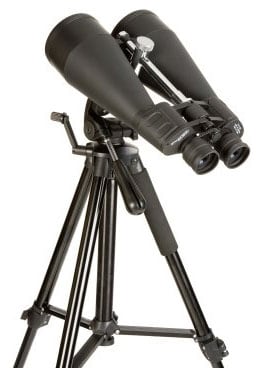
So for example something like a 25x100 (25x magnification with 100mm lenses), or a 20x80 binocular will be excellent for astronomy and in low light when the sun is setting for example as the two very large 80mm/100mm lenses can take in plenty of light, but at the same time, it results in the binocular also being very large and heavy. This is not a major issue with the right tripod set-up (see below).
With such high power, you are also going to be able to view more details on your subjects at distance, but at the same time, being so “zoomed-in”, you are also going to get a much narrower view, which is not great for following moving objects. Like the birds especially.
So for me, this set-up would be the way I would go if astronomy was my major interest.
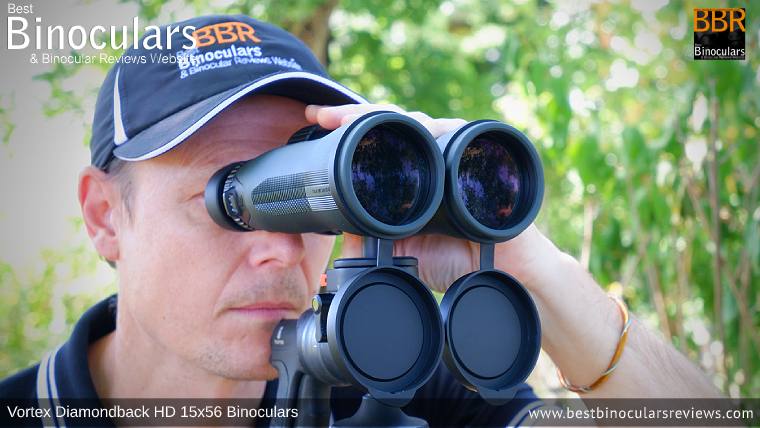
Large, High Powered Binoculars
If we scale back the magnification and lens size a little (so something like an 18x56, 15x56, or perhaps a 20x70), we can get a slightly more versatile instrument that is easier to handle and still achieve a good level of image detail and low light performance.
The other big advantage here for daytime use, in particular, is that you get a wider field of view making it easier to locate and then track moving wildlife.
So this is the route I would probably follow if wildlife observation during the day was my main interest and not astronomy.
For more on this and a few ideas that may interest you, take a look at my guide to High Powered, Long Distance Viewing Binoculars.
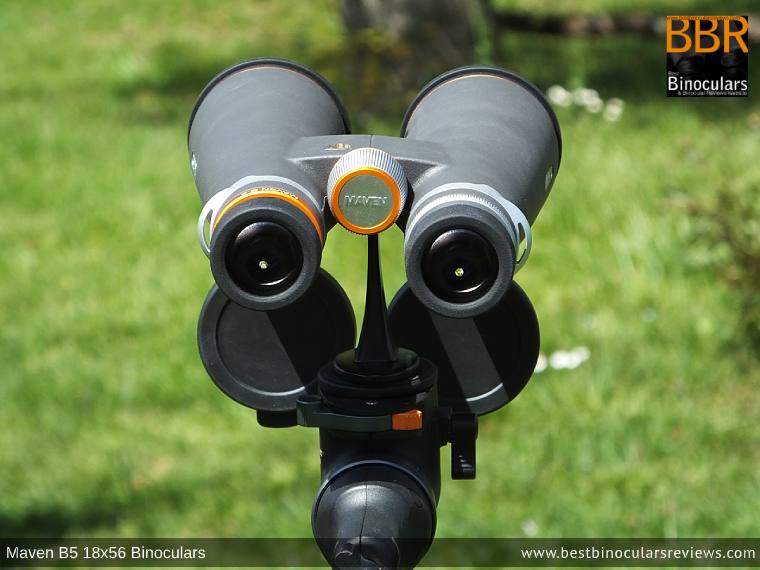
Question to You
So I think here before I start offering up some recommendations, the next question I have for you is, out of the two options above, which one interests you most:
Very Large & Very Powerful versus Large and Powerful with a Wider Field of View?
Also in anticipation, below I have added some information on some ideas for your tripod set-up that you can start to consider and take a look at:
Tripod Setup
As you will be using your binoculars for astronomy as well as terrestrial observation, the main consideration her is to make sure that the tripod you get can extend enough so that you can get under the binoculars inorder to look up into the sky.
Here it is also important to keep in mind that at this maximum level of extension, it will still need to be steady and thus it often pays off in the end not to skimp too much as I have found that higher-end tripods are just made better using, better more robust materials and with more exacting tolerances. When collapsed you may not notice much of a difference, but when fully extended with a fairly heavy binocular ontop, these seeingly small differences can and do add up.
However, much like the binoculars, you do not need to go crazy here, I just recommend staying away from the low-end of the spectrum.
For some ideas as to what I use and would recommend, take a look at this article on My Tripod setups for Binoculars & Spotting Scopes: Astronomy & Terrestrial Surveillance
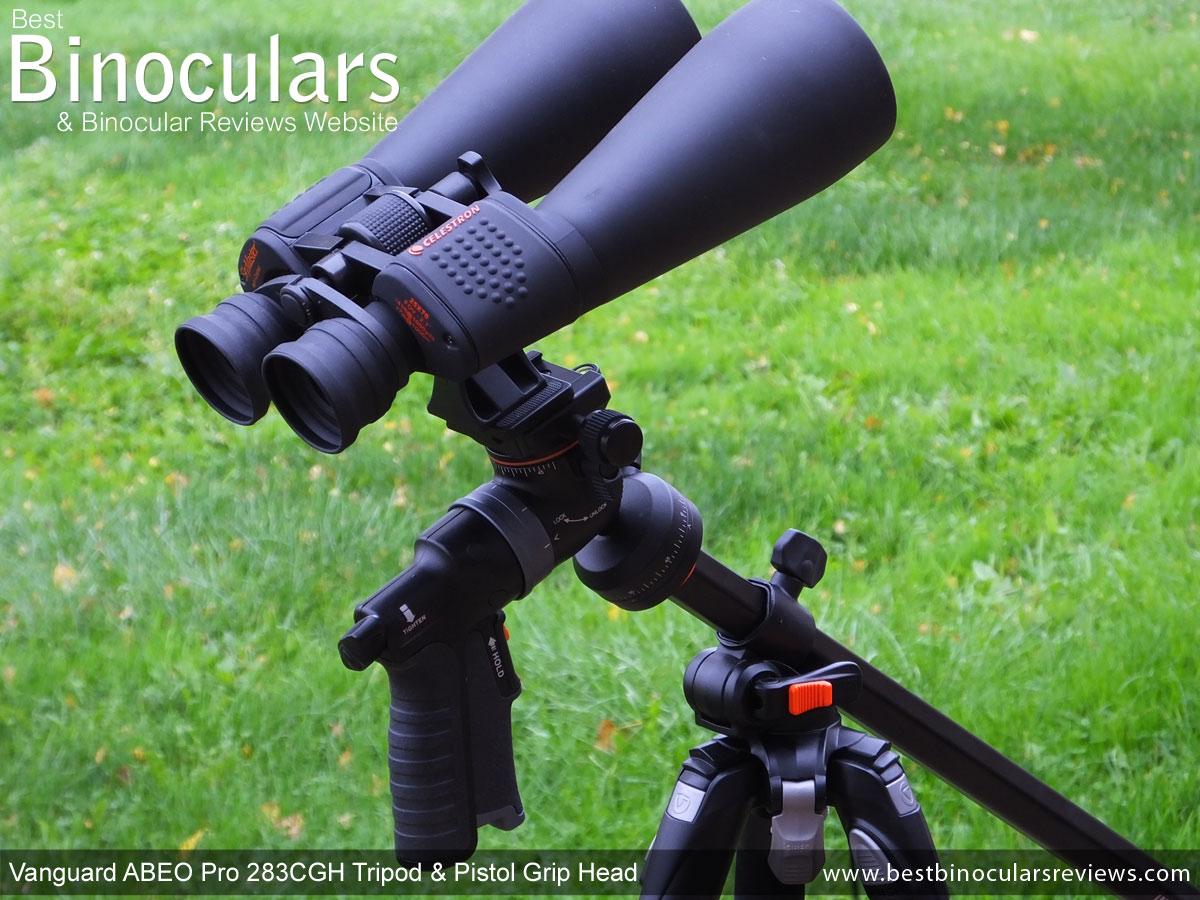
Response 02
Thanks Jason.
I think, for me, very large, very powerful binoculars would be the best choice.
I understand the benefits of something slightly less large and powerful, but I am not particularly concerned about tracking moving targets or scanning for targets.
Most of what I look at is pretty stationary or slow-moving. Plus I like that very large, very powerful binoculars will be good for astronomy, so that seems like the best option for me.
Reccomendations
Right, so now that we have established that magnification (image detail at distance) is your main priority on the understanding of the drawbacks to it that includes the instrument being large and heavy and having a narrower field of view, we can start to take a look at a few options:

Celestron 20x70 Echelon Binoculars
Of the binoculars that I have tested in this niche, the Celestron Echelon stands out.
Assembled in the USA using high-end Japanese optics both the build quality and the views you get through them are excellent and since testing them, I have had no hesitation in highly recommending them.
Whilst not the most powerful option and the 70mm lenses are not the largest, I do feel that they offer a good crossover between a binocular for astronomy and long-range daytime use and feel they could make an excellent option for your needs.
Main Specifications
- Field of view: 157ft @ 1000yds
- 19.5mm Eye-Relief
- Minimum Focus: 328ft
Availability & Price
On the downside, they can be hard to find, although I have just checked (see where to buy link below) and found that they are available from B&H and currently listed at $919.99 which is not cheap, but I think when you consider the level is not at all bad.
I also see that B&H have a kit option that includes the tripod adapter and a tripod. This kit is actually cheaper than buying the binocular by itself!
So whilst I don’t know the quality of the tripod and thus would not go for this option primarily because of the kit, if you were interested in this binocular, get the kit version because if the tripod turns out to be a little too flimsy, you could always get another one later and use this tripod for a more lightweight binocular or camera.
Steiner 20x80 M2080 Military Binoculars
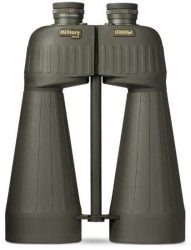
Another interesting high-end option are these German-made 20x80 binoculars from Steiner.
Now whilst I have not tested them myself, I have reviewed a lot of Steiner binoculars over the years and so I am confident they will be as tough, well made and offer a performance at least as good (if not better) than the excellent Steiner HX 15x56 Binoculars, which are certainly one of the best high-power instruments I have come across.
Main Specifications
- Field of view: 195 ft at 1000 yds
- 13mm Eye-Relief
- Minimum Focus: 197ft
I like that they have larger 80mm lenses and thus with the quality of the optics and coatings, the same 20x and the resulting 4mm (80mm/20x) exit-pupil these will likely be a little better in very low light conditions when viewing wildlife than the Celestron. For astronomy, this is not always the case as you are generally looking at bright shining stars and the moon, but it can make a difference in being able to spot dimmer objects in the night sky.
I also like that despite having the same 20x magnification, they have a wider field of view and so whilst I know you said that this was not too important to you, it is always nice to get more in the view at one time. For astronomy this also makes it easier to navigate the night sky.
Price
However, you do pay for all this. Currently listed at $1,684, these are quite a lot more expensive than the Celestron’s:
Celestron SkyMaster Pro 20x80 Binoculars
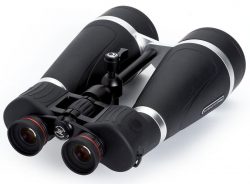
For a much less expensive option, I would highly recommend considering the 20x80 version of Celestron’s SkyMaster Pro Series of binoculars.
Whilst I haven’t tested this model, I have reviewed the less powerful and smaller 15x70 Celestron SkyMaster Pro Binoculars and I must say that I was really impressed and feel they offer an excellent performance to price ratio and have no reason to believe that the 20x80 version will be any less impressive.
Just a point to note here: if you are interested, make sure you go for the SkyMaster PRO series and not the standard SkyMaster binoculars which are of a much lower quality and I feel you will not meet your expectations or requirements.
Main Specifications
- Field of view: 168 ft at 1000 yds
- 15.5mm Eye-Relief
- Minimum Focus: 66.2ft
Price
Whilst these don’t match the Celestron Echelon or the Steiner M2080 above, at around $260, I think they offer a performance and build quality that far exceeds their much, much lower price tag. Or to put it another way, are the other binoculars on this page better than these…Yes, but are they 4x or 5x better… No. So for this and many other reasons, I do feel they are well worth consideration:
Anyway there are a few ideas for you to consider. As I say take some time to read the reviews or my reviews of similar models that will give you a good idea as to what you can expect.
It will also be interesting to get your thoughts and we can take it from there.
Response 03
Thanks very much for these recommendations Jason. They all look great.
Minimum Focus Distances
With respect to the minimum focus on these binoculars, does that actually mean that I cannot use them at distances of less than that?
There is a rock outcropping about 150 meters away from where a lot of activity happens that I would like to watch. The first 2 options have minimum focus distances of greater than that. Does that mean I would not be able to use them at that distance?
Answer 03
Individual Eye-piece Focus & Min Focus Distance
Hi Simon, the very short answer is yes… and no! Let me try and explain:
The majority of very high-powered binoculars like these forgo the central focusing mechanism that adjusts both barrels simultaneously that you no doubt will be used to seeing on most standard/normal sized binoculars.
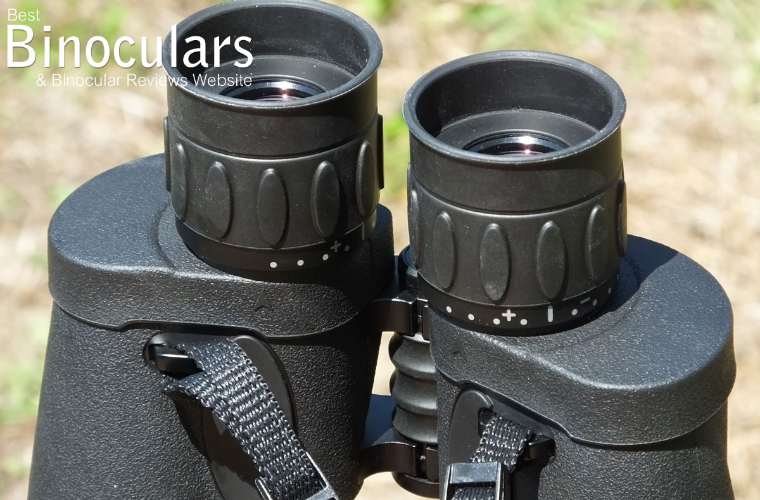
Individual Eye-piece Focusing on the Celestron 20x70 Echelon Binoculars – showing the Diopter Adjusters on both eyepieces
Instead, they use what is sometimes referred to as an Individual Eye-piece Focus system, but sometimes is described using terms like focus-free, auto-focus, or self-focusing binoculars, all terms that I feel are very misleading.
I have a whole article on Self Focusing Binoculars, Fixed Focus & Individual Focus Binoculars, that you can go through, but in short, they basically have an optical system with a very long depth of view and thus once you have set them up to your particular vision by adjusting the diopter (a type of focussing mechanism) on each eyepiece, it will mean that everything will be in focus from the minimum focus distance right to infinity and so no more focal adjustments are required.
So because they have such a long depth of view, this minimum focus distance at this “infinity” setting tends to be very long in comparison to the figure supplied with “standard” focusing binoculars.
However, you can focus these binoculars to a closer range, but instead of using a single focus wheel as on a standard binocular, you adjust each of the eye-pieces individually. So it is possible, just a little slower and less convenient.
As these binoculars are designed for long distances, the thought is that this would be fairly rare, and thus the advantages of not having to continuously focus on objects in the distance outweigh this inconvenience.
You will notice that the Celestron SkyMaster Pro 20x80 Binoculars use a central focus mechanism and that is why their “officially stated” minimum focus distance is quite a lot less than the other two.
Also just to point out that these measurements are all in feet so at 328ft even the Celestron 20x70 Echelon Binoculars are able to focus at a distance of under 100 meters at the infinity setting (328ft = 99.97m). So they should still be fine for you?
So by adjusting the eye-pieces when you need to you will be able to focus to closer ranges than this and on top of this, I have found that the stated measurements are “worse case scenarios” as I have almost always been able to focus to a distance under that of which the manufacturer states.
Maven 18x56 B5 Binoculars

If having an individual eye-piece focusing mechanism is of concern to you, as well as a few instruments like the Celestron SkyMaster above, we could also tone down the power a little and opt for something like these incredible 18x56 Maven B5 Binoculars.
Winner of the Best High-Power Binoculars Award for this year, they are obviously still very powerful, but with the centrally located focus wheel and smaller lenses, they are just a little more versatile.
Yes, the smaller lenses will mean that they don’t collect as much light, but the extremely high level of optics and coatings on them does make up for this to some extent.
- Eye Relief 18.0mm
- Fov: 194ft @ 1000yds
- Near Focus: 9.8ft
As you can see they have a MUCH nearer minimum focus distance, a wide field of view for such a high powered instrument and plenty of eye relief.
These extremely well-made, high-end binoculars, currently retail for around $1500 / £1600 / €1500, and I really do feel they would be well worth your consideration as they are certainly up there with the best I have ever used:
Response 04
Thank you for pointing out the feet vs meters. You are correct that any of the ones you recommended would be fine for me in terms of distance.
From what I’ve read, it seems that the benefits of a central focus knob aren’t really a concern for me. Most of what I watch is relatively static, so I think individual eye focus would be better.
Sharing Binoculars
One question I have about focus though is the convenience of giving the binoculars to someone else to use without needing a lot of readjustment.
If I have the binoculars set for my focus and I want to pass them to my wife to look at something, does that require her to refocus them to use them?
Is individual or central focus better for this? That may be a basic question, but keep in mind I’ve never really used binoculars other than as a toy when I was a kid.
Eye Relief
I would also like to know about eye relief. Is that a figure I should be thinking about?
Answer 04
Sharing Binoculars
If your eyesight between your left and right eyes differ, with a pair of Individual Eye-piece Focus binoculars, you will naturally just adjust the two eyepieces slightly differently to get a sharp image in each of them.
With a standard pair of central focus binoculars, you have to make an adjustment to the diopter to compensate for the difference.
Thus if you were to then share your binoculars with someone else who perhaps has for example vision that is the same in both eyes, they would need to make adjustments no matter which type binocular you have.
In some ways this process would be a little easier with the Individual Eye-piece Focus binoculars as you will be more used to making these adjustments.
If you are lucky and you both have a similar vision, then no adjustments will be necessary.
Eye Relief
For the vast majority of users, the amount of eye-relief is only really a factor if you want or need to wear glasses whilst using your binoculars as most will come with more than enough to allow for the slight differences in the shape of our faces and how far our eyes sit back compared to others.
If you do need or indeed want to wear glasses, then for some people (depending on the shape of their face and their glasses) 14 to 15mm of eye-relief can be sufficient, but to be safe, I have found around 17 – 18mm of eye-relief is usually more than enough to ensure you can see the full image without black rings forming on the edges. I have more info on my page about Long Eye Relief Binoculars if you are interested.
Feedback & Follow-Up Questions
I just wanted to follow up with you now that I’ve had my Celestron 20x70 Echelon Binoculars for about a week. I love them! They are very easy to use, comfortable to hold, and obviously very well made.
The tripod that came with them is not the greatest- it has a little bit of play where the piece you screw into the binoculars connects to the stand, so it jiggles and shifts a little bit when you’re holding it, but it’s still usable.
Depending on how much they cost, I would like to get a better one and would appreciate your recommendation on that.
Looking at the moon through these binoculars is amazing and I already want to see more!
Do you know about telescopes as well? Is that something you could help me select?
Also, I read a little bit about looking at the sun with a solar filter. Do you know if that can be done with these binoculars and, if so, where I can get some filters?
Thank you very much for all of your assistance so far. I really appreciate it!
Answer 05
Hi Simon, many thanks for the feedback, and glad to hear that you are enjoying your new binoculars. It is a truly excellent set.
Tripods
As with most “free gifts” they quality is not always the best, so I’m not surprised the included tripod in this deal is not the best, but we can sort that no problem and you will have that one as a backup or for more lightweight binocular/camera.
I recently wrote an article on the Tripods that I use for Large, Powerful Binoculars – this is for both terrestrial and astronomy.
Whilst I have not used anywhere near as many tripods as I have binoculars, I can highly recommend both the Vanguard and Bresser ones that I mention in that article.
Telescopes
I only have limited experience with telescopes, and can only go on what I have and use: BRESSER Polaris 102/460 EQ3 Telescope – for starting out and for the cost I am more than happy with it.
Solar Filters
Sorry, I am not much help here as I have never used one, if I recall, Celestron do make one for binoculars, but I may be confusing this with their Telescopes as I looked into it when I was researching buying a telescope for myself.

 Article | Posted by Best Binocular Reviews
Article | Posted by Best Binocular Reviews 

 Categories:
Categories:  Tags:
Tags: 
